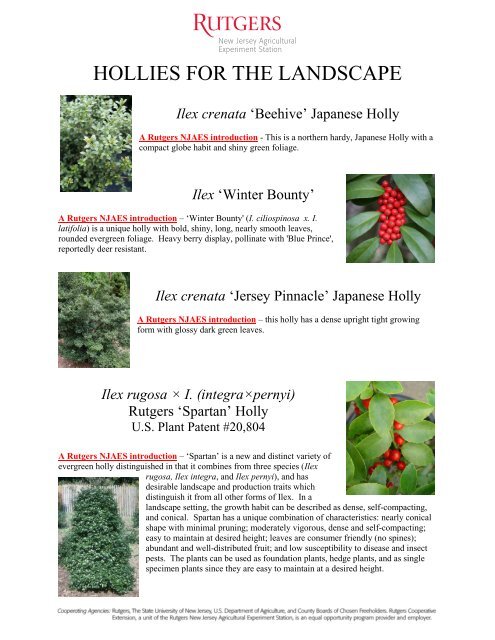HOLLIES FOR THE LANDSCAPE
Hollies for the Landscape - Snyder Farm
Hollies for the Landscape - Snyder Farm
- No tags were found...
You also want an ePaper? Increase the reach of your titles
YUMPU automatically turns print PDFs into web optimized ePapers that Google loves.
<strong>HOLLIES</strong> <strong>FOR</strong> <strong>THE</strong> <strong>LANDSCAPE</strong><br />
Ilex crenata ‘Beehive’ Japanese Holly<br />
A Rutgers NJAES introduction - This is a northern hardy, Japanese Holly with a<br />
compact globe habit and shiny green foliage.<br />
Ilex ‘Winter Bounty’<br />
A Rutgers NJAES introduction – ‘Winter Bounty' (I. ciliospinosa x. I.<br />
latifolia) is a unique holly with bold, shiny, long, nearly smooth leaves,<br />
rounded evergreen foliage. Heavy berry display, pollinate with 'Blue Prince',<br />
reportedly deer resistant.<br />
Ilex crenata ‘Jersey Pinnacle’ Japanese Holly<br />
A Rutgers NJAES introduction – this holly has a dense upright tight growing<br />
form with glossy dark green leaves.<br />
Ilex rugosa × I. (integra×pernyi)<br />
Rutgers ‘Spartan’ Holly<br />
U.S. Plant Patent #20,804<br />
A Rutgers NJAES introduction – ‘Spartan’ is a new and distinct variety of<br />
evergreen holly distinguished in that it combines from three species (Ilex<br />
rugosa, Ilex integra, and Ilex pernyi), and has<br />
desirable landscape and production traits which<br />
distinguish it from all other forms of Ilex. In a<br />
landscape setting, the growth habit can be described as dense, self-compacting,<br />
and conical. Spartan has a unique combination of characteristics: nearly conical<br />
shape with minimal pruning; moderately vigorous, dense and self-compacting;<br />
easy to maintain at desired height; leaves are consumer friendly (no spines);<br />
abundant and well-distributed fruit; and low susceptibility to disease and insect<br />
pests. The plants can be used as foundation plants, hedge plants, and as single<br />
specimen plants since they are easy to maintain at a desired height.
Ilex x ‘Rutzan’ ‘Red Beauty’ Holly<br />
U.S. Plant Patent No. 14,750<br />
A Rutgers NJAES introduction - Red Beauty® is a new and distinct variety<br />
of evergreen holly distinguished in that it combines from three species (Ilex<br />
aquifolium, Ilex rugosa, and Ilex pernyi), and has<br />
desirable landscape and production traits which<br />
distinguish it from all other forms of Ilex. Leaves do<br />
not become lighter green when bearing a heavy crop<br />
of fruit as do the leaves of many varieties of Ilex. A<br />
unique conical or pyramidal shape can be achieved by<br />
simply developing a central leader, which will also increase the height. Red<br />
Beauty® has a unique combination of characteristics: unique combination of<br />
berries, leaves, flowers, form, compactness, and hardiness; abundant, bright red<br />
berries and dark green glossy foliage, medium-size spiny leaves; narrow to<br />
moderate conical form with little to no pruning, dense branches; high hardiness<br />
level in Zones 6 to 10; mature size 7 to 10 ft. tall, 4 to 5 ft. wide after 7+ years;<br />
small white flowers in spring; and highly deer resistant (demonstrated). ‘Blue<br />
Prince’ also in the collection, is a pollinator for ‘Red Beauty’.<br />
Ilex opaca ‘Jersey Knight’<br />
A Rutgers NJAES introduction - The ‘Jersey Knight’<br />
American holly grows vigorously to form a dense, upright<br />
pyramid of satin-glossy, dark green foliage. In full sun locations,<br />
it becomes quite symmetrical in silhouette. The species is a<br />
broadleaf evergreen tree native to the central and southeastern<br />
portions of the United States. This cultivar was introduced into<br />
the horticultural trade in 1965 by Dr. Elwin Orton of Rutgers<br />
University, who discovered it growing in the yard of New Jersey<br />
Judge Thomas Brown in 1945. A male selection, ‘Jersey Knight’<br />
does not produce fruits but bears tiny white flowers in spring that bees visit. This cultivar supplies the<br />
pollen needed for any nearby female American holly to yield berries later in the season. ‘Jersey Knight’ is<br />
a standard, steadfast pollinator tree for the landscape. Excessive shade will result in more open, leggy<br />
growth. American holly makes a stately solitary specimen, and is suitable for large hedges, large-scale<br />
foundation plantings and spacious shrub borders. Its cut boughs, even without berries in the case of<br />
‘Jersey Knight,’ are a festive addition to winter holiday arrangements.<br />
Ilex opaca ‘Jersey Princess’<br />
A Rutgers NJAES introduction - Widely considered<br />
one of the finest fruiting cultivars, this Rutgers offering<br />
holds its lustrous green leaf color and bright red fruit well<br />
into winter. This tree becomes a dense, upright pyramid<br />
of glossy foliage that rivals that of any English holly.<br />
‘Jersey Princess’ is a Dr. Elwin Orton selection from<br />
Rutgers University, and is among the most commercially<br />
available and winter-hardy of cultivars. A female<br />
selection, ‘Jersey Princess’ produces tiny white flowers in<br />
spring that bees visit. Pollen from nearby male holly<br />
trees is necessary for any berry production on this plant.<br />
‘Jersey Princess’ prefers full to partial sun locations with<br />
moist, fertile, average to well-drained, non-alkaline soil.


